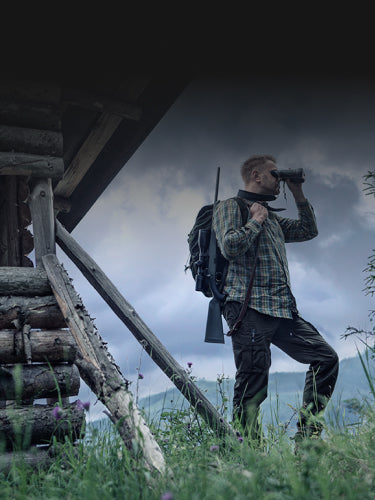*Check with local law enforcement regarding the legalities of hunting at night. This content should not be regarded as legal advice.
When delving into hunting laws, things get convoluted and certainly confusing. There are many restrictions, rules and regulations—what type of firearm, ammo and caliber you can use, when, where and what you can hunt, as well as which equipment and accessories are allowed—all defined by state laws because there are hardly any federal hunting laws. Universally, it is illegal to hunt any game animal at night—this includes deer, turkey, and moose. You can, however, hunt non-game animals at night in all but two states: New Mexico and Rhode Island; in those places the only thing you can hunt at night is raccoons, and even then only with a permit.
In states that have legalized nighttime hunting, it is only for fur-bearing, predators, varmints, exotics and other non-game animals. Fur-bearing animals are those mammals covered in fur and mainly hunted for their pelt, like foxes, rabbits and raccoons. Varmints are small pest animals like prairie dogs and squirrels. Predators are animals that hunt or prey on other animals as a means of survival, like bobcats or coyote. Animals are classified as exotic when they are not native to the state, like Barbary sheep or Ibex deer. Each state differs in what species people can hunt at night and which gear is legal to use.
The restrictions placed on what type of optic hunters can use is based on what type of light the optic utilizes. Hunters use many different types of lights and optics when scouting, spotting and shooting. Traditional handheld, head-mounted, weapon-mounted, and vehicle-mounted lights are all popular different types of hunting lights. These lights project a white, red or green beam to illuminate an area. Green and red lights are more popular than white for night hunters. It is said that green and red do not spook game and help prevent eye fatigue for the hunter. Many states define “any light that projects on the animal” as illegal. Check the local and state laws to know for sure.
Other optics which hunters use include night vision, digital day/night vision or thermal imaging in the form of riflescopes, monoculars and binoculars. Night vision uses an image intensifier tube requiring some form of light, either artificial or natural, to produce an image. Digital day/night vision uses a charge-coupled device or metal-oxide semiconductor; it also needs a source of light to produce an image. Thermal imaging detects heat signatures and needs no light source to produce an image.
You can use thermal and digital during the day, but you can ruin the night vision’s image intensifier tube if exposed to sunlight. Night vision makes use of external infrared light as the source to produce the image. Warm-blooded animals, including humans, cannot see the infrared but technically it can be defined as “light that projects on the animal” even though it is invisible. Because thermal does not need or use any type of light to work, there aren’t laws against using it. Hunters enjoy thermal because this allows them to put a thermal scope on their firearm and smoothly transition from day to night hunting without having to switch, and even possibly re-zero, their optics.
Can Animals See Infrared Illuminators?
Often, people wonder if animals can see a light emit from an IR illuminator. IR illuminators do not throw a visible beam of light. This is why some hunters prefer IR illuminators and night vision devices – because they are designed to not spook game. Only the source, such as a bulb, may be visible while looking directly at it (depending on the type). Though it is an arguable subject, some say the visibility of an IR depends on its wavelength. 940nm is supposed to be completely invisible while looking directly at the source, while 850nm gives off a slight red glow from the source.
In this article, we will discuss the states that DO allow the use of night vision, IR illuminators, digital and thermal devices for hunting at night. If your state isn’t listed, it is not legal for you to use night vision or any type of light-emitting devices, or even hunt at night.
Many states don’t allow the use of night vision when you have a firearm with you, but observing wildlife or scouting is fine.
Thermal devices are not classified as the same as night vision devices. They use separate technology to operate. Night vision devices with an IR illuminator, either built-in or detachable, are considered a form of artificial light, which is what makes hunting with it illegal. Since thermal does not emit any light, they are legal.
States you can use artificial lights while hunting:
Alabama
Arizona
Arkansas (Hogs on private land only)
Colorado (Raccoon, coyote, bobcat, striped skunk, beaver and red fox on private land only)
Idaho (permit required)
Illinois
Iowa- no IR illuminators allowed
Kentucky
Louisiana
Maine (Raccoon, permit required to hunt coyotes at night)
Massachusetts
Minnesota (From Jan. 1 to March 15, only on foot, using a shotgun and a calling device and not within 200’ of a vehicle)
Mississippi
Montana
North Carolina
Nevada
New Hampshire
New Jersey
New York
Ohio
South Carolina (Only hog, coyote and armadillos on registered property)
Texas
Virginia
Washington
Wyoming
For those living in states where it is legal to hunt at night, the use of night vision devices can make or break your hunt. If you are interested in learning more about the differences between thermal and night vision and picking the right optic for you, read the following articles on the official Pulsar Blog.




1 comment
Your information is incorrect. In New Mexico you can hunt nongame species at night as long as you do not cast an artificial light. This would include an IR Illuminator, spotlight, etc. However, you can use thermal imaging. Even though New Mexico doesn’t state this, you can clarify with the NM Dept of Game & Fish as I did.